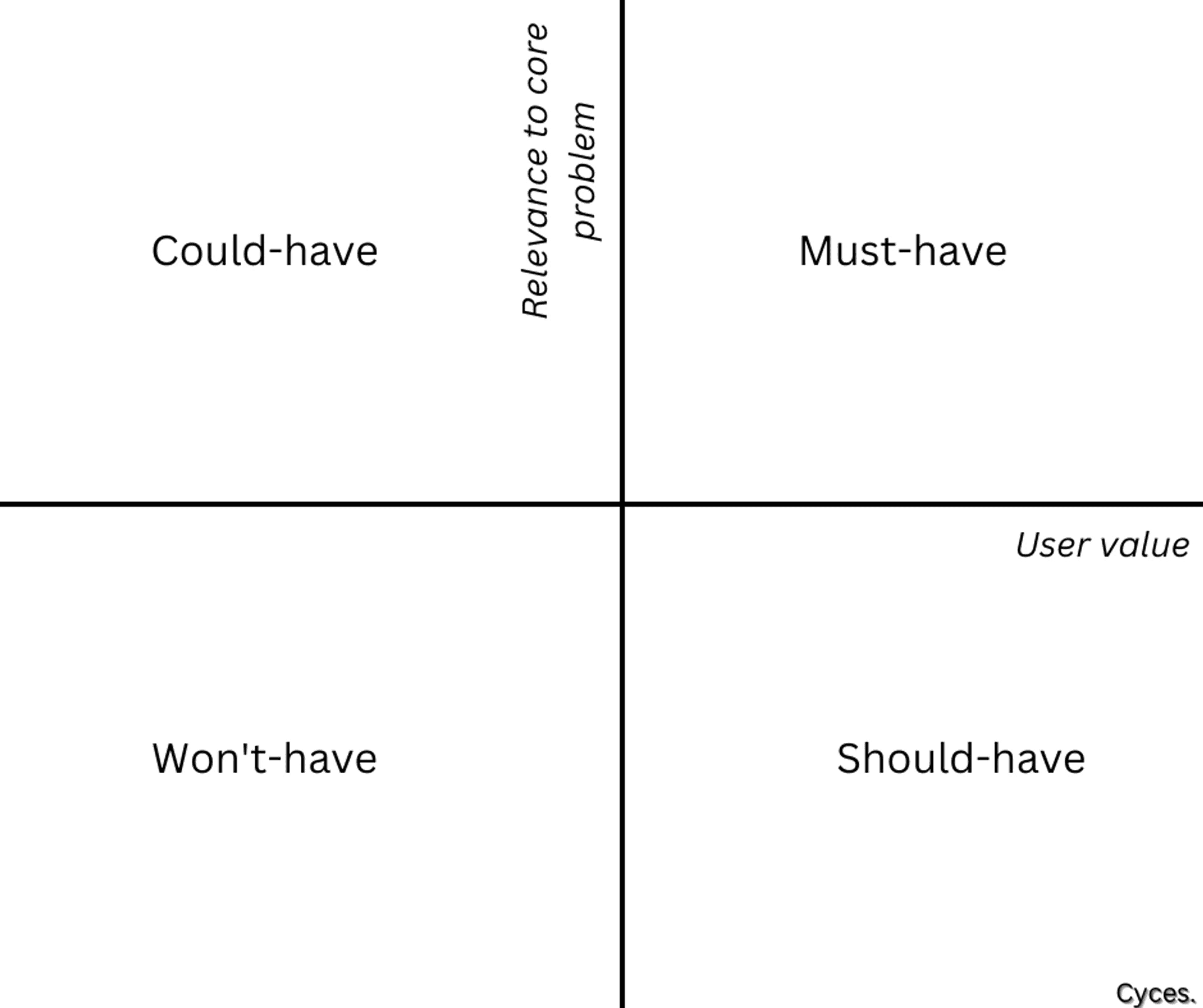
mvp
Launching a Minimum Viable Product (MVP) can feel like walking a tightrope. You're constantly balancing between what's absolutely necessary and what's just nice to have, all while trying to predict how your target audience will react. You might misjudge the market, overload your MVP with features, skimp on user experience, or miss the mark on your MVP's core value.
There's a way to dodge these pitfalls and it's called product thinking. It's not a magic wand, but it does bring clarity to the chaos of MVP development. As a trusted partner in this domain, we at Cyces have adopted the product thinking approach to help us navigate the complexities of building successful MVPs.
This guide is all about rethinking the MVP development process. We'll share our insights and take you on a deep dive into the world of product thinking.
In the traditional MVP development process, the focus often lies in getting a product out into the market quickly. While speed is indeed crucial in the world of startups, this "rush job" can often lead to MVPs that are disjointed from what users actually need or want.
In contrast, product thinking puts users at the center of the MVP development process. It helps us create a product that solves real problems, not just adds features or technology for the sake of it.
It's a philosophy that insists on understanding users deeply: Who are they? What do they need? Why do they need it? It's about stepping into the users' shoes, feeling their frustrations, and identifying their needs. We then use these insights to define the problem that our MVP will solve. This approach ensures that we're not just building a product that works, but one that our users will genuinely love and find value in.
Product thinking also helps us prioritize better. When we understand our users and their pain points, it becomes easier to decide what features are absolutely crucial for the MVP and what can wait. We can focus on what truly matters instead of getting distracted by 'bells and whistles' that don't really serve our users.
Product thinking is an ongoing process. It doesn't stop once the MVP is launched. We continuously learn from user feedback, iterate, and improve, ensuring our product evolves in line with user expectations and market dynamics.
In a nutshell, we at Cyces are obsessed with product thinking because it empowers us to build MVPs that are not just minimum and viable, but also desirable, feasible, and valuable from the very start.
We've all followed the classic 'build-measure-learn' steps to a tee, hoping they'd lead us to an MVP that users will love. But let’s be real. Just going through the motions isn’t cutting it anymore. If you want to build an MVP that doesn't just function but is adored by users, it's time for a change in perspective.
Instead of taking a one-size-fits-all approach, we're going to start with understanding our users and their problems. We'll then ideate, validate, and prioritize based on these insights, ensuring our MVP is genuinely user-centric.
This is where our obsession with product thinking really comes into play. Before you jot down a single line of code or sketch a single wireframe, you need to understand your users. Like, really understand them.
Start by defining who your users are. Create user personas to encapsulate their demographics, behaviors, needs, and motivations. Next, gather as much information as you can about these personas. Engage in user interviews, conduct surveys, and observe them if possible. The goal is to get a deep, empathetic understanding of their challenges, needs, and desires. This is the foundation upon which everything else is built.
Now that you know your users like the back of your hand, it's time to zero in on the problem that your MVP will solve. It needs to be a real problem that your users face, one that they care enough about to seek a solution.
Take all the insights you've gleaned from step one and use them to clearly define this problem. It might be tempting to jump straight to solutions but resist the urge. You're not ready for that yet. Spend time honing in on the problem, refining it, and understanding its nuances. You should be able to articulate it in a simple, clear statement.
You understand your users. You've defined their problem. Now it's time for the fun part: coming up with solutions. This is the brainstorming stage where no idea is off the table.
Gather your team and start generating as many solutions as possible for the defined problem. Encourage wild ideas, combine and improve on ideas, and most importantly, focus on the users. How can your product alleviate their problem? What features would it need to do so? Record all ideas for the next step, where you'll test their viability.
Not all ideas that shine during brainstorming can stand up to the harsh light of reality. This is why validating your solution is critical. You don't want to put time, effort, and resources into building something that sounded great in theory but falls flat in the real world.
Take your top ideas from the ideation process and expose them to some reality checks. Run them by actual users through surveys or interviews, test them against market trends and data, and consider creating a simple proof of concept. The goal is to gather evidence that supports the potential success of your solution.
By the end of this step, you should have a validated solution that not only sounds great on paper but also has some real-world backing to its name. And with that, you're ready to dive into the actual building process.
Remember, product thinking isn't about ticking off steps. It's a mindset where the user is always at the heart of everything you do. Understanding your user and their problem, and validating your solution are the building blocks of an MVP that users will love. So take your time, dig deep, and let the insights guide you.
With a validated solution in hand, it's time to decide what goes into your MVP and what doesn't. Feature prioritization is an art that can make or break your MVP.
Firstly, list all the features that your product could potentially have, and then rank them based on the value they provide to the user and their relevance to the core problem you're solving. A common method for this is the MoSCoW method, where you categorize features into 'Must-have', 'Should-have', 'Could-have', and 'Won't-have'. The features that directly address the user problem and are essential for the MVP to function are your 'Must-have' features. They make it to the MVP.
The 'Should-have' and 'Could-have' are nice-to-haves that could potentially increase the value of your product but aren't crucial for its basic functioning. They can wait. Prioritizing ensures that you're focusing on what truly matters and keeps your MVP lean and purposeful.

Now that you know what features your MVP needs, it's time to start building. Depending on the nature of your product, this could involve coding, designing, copywriting, and a host of other activities.
But building isn't just about putting the pieces together. It's also about constantly checking back with your users and your problem statement to ensure you're on the right track. At every step of the way, ask yourself, "Is this serving my user? Is this solving their problem?" This is also the stage where you'll decide on the technology stack that best suits your MVP's requirements and long-term scalability.
Why you should outsource your MVP development to an agency
Just because your MVP is built doesn't mean it's ready for launch. A crucial part of the process is testing. This is where you ensure your MVP not only works as expected but also provides a smooth, hassle-free experience to the user.
Conduct rigorous testing to spot any bugs or glitches. Look for any potential improvements in design or user interface. It's far better to identify and fix these issues now than to wait for your users to find them.
Congratulations! You've made it to the launch stage. But don't pop the champagne just yet. Launching your MVP is just the beginning of your journey.
Once your MVP is in the hands of users, pay close attention to their feedback. What are they saying about your product? What do they love about it? What do they wish was better? This feedback is pure gold. It will guide your future iterations and help you further refine your product to better serve your users.
Remember, an MVP is not a one-and-done deal. It's a continuous process of learning, iterating, and improving. Keep your ears to the ground, listen to your users, and let product thinking guide your way to an MVP that users will truly love.
On a broad scale, MVP development can range from as low as $5,000 for a basic MVP with a limited set of features to over $50,000 for a more complex one with advanced features and functionalities. But remember, these are just ballpark figures. The actual cost can differ based on your unique requirements.
The timeline for building an MVP depends on various factors such as the complexity of the project, the number of features, the development approach, and how quickly decisions can be made. A basic MVP with a few key features can be developed in as little as 4 to 8 weeks, while a more complex one could take several months. It's also important to account for additional time for testing, iterations, and improvements based on user feedback.
But no matter the MVP timeline, the focus should be on delivering a product that serves your users and solves their problems.
Building an MVP that users will love is no small feat. It requires a deep understanding of your users, a clear definition of their problem, ideation and validation of solutions, and a strategic approach to feature prioritization. But even with all this, the success of an MVP isn't guaranteed. There's still the complex task of actual development, rigorous testing, and the iterative learning process post-launch. And let's be real, not every startup or business has the resources, time, or expertise to handle all this in-house.
That's where an experienced MVP development agency like Cyces comes into play.
At Cyces, we live and breathe product thinking. We've honed our skills and refined our processes to ensure that every MVP we develop is laser-focused on user needs. We have a dedicated team of professionals who will dive deep into understanding your users, their problems, and work relentlessly to come up with solutions that truly resonate with them.
When you work with us, you're not just outsourcing the development task; you're gaining a partner who is as invested in your success as you are. We collaborate with you, guiding you through each step of the process, and leveraging our expertise to help you avoid common MVP mistakes.
Moreover, we bring a wealth of experience in technology, design, and market dynamics to the table. We're adept at testing and validating solutions, prioritizing features, and using cutting-edge technology to bring your MVP to life. And once your MVP is out there in the world, we don't just walk away. We're in it for the long haul, assisting you with gathering and interpreting user feedback and iterating on your product.
Outsourcing your MVP development to Cyces doesn't just take the load off your shoulders; it increases your chances of building an MVP that users will love. So, why take the winding path when you have a straight route to success? Reach out to Cyces, and let's build an MVP that doesn't just meet expectations but exceeds them. Let's build an MVP the product thinking way!
Read more:
leveraging tech for
business growth
Cyces.